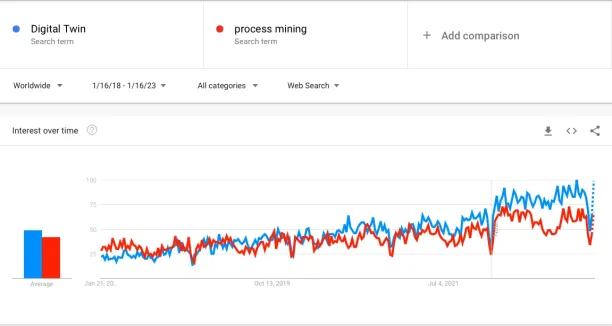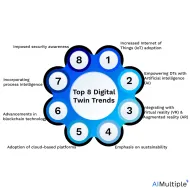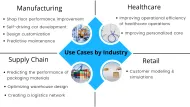Complete Guide to Digital Twin of an Organization (DTO) in '24
The global digital twin market size was valued at $3 billion in 2020 and is estimated to reach ±$73.5 billion by 2027.1 We’ve explained what digital twins are, how they work and what are their use cases before in our digital twins and digital twin applications. One of the recent concepts emerging from digital twins is a digital twin of an organization (DTO). DTOs are built to analyze an organization’s processes or services in a virtual environment to run simulations and address issues which may confronted the business in real-life situations.
Though vendors use numerous terms like DTOs, process mining and task mining to differentiate their messages, these solutions rely on similar technologies. However, we notice that DTO solutions focus more on holistic, organization-wide simulations to generate insights.
What is a digital twin of an organization?
A digital twin of an organization (DTO) is a virtual model of a physical process, product, or service, which includes data about:
- Previous performance
- Business goals
- Business models
- Business processes
- Performance KPI indicators with target levels
- Detailed transaction-level situational process analysis
To optimize performance, DTO models require consistent updates about the organization’s functioning, resource utilization, product quality, and meeting customer needs.
Explore DTO use cases in detail.
Benefits of leveraging a digital twin of an organization
A DTO provides a virtual model of complete businesses, instead of hardware, which enables business leaders to analyze, and tweak business processes as needed. DTOs enable the dynamic virtual representation of an organization in its operational context, which provides:
- Digital representation of employees, processes, data, and assets as they exist in the physical world, which enables:
- Enhanced coordination among employees in an organization
- Identification of an organization’s inefficiencies or weakness
- Platform to train employees on work operations and new practices
- Predictive analyses about:
- outcomes of changes in process, product, or service
- risks and costs of adopting new processes or leveraging new technologies
Digital twin of an organization software vendors
DTO software is still an emerging technology in the market compared to digital twin technology. However, some companies are providing DTO software to analyze business processes, monitor and predict the future evolution of processes. Here’s a list of DTO vendors:
| Company | DTO Platform | Founded | Number of employees | Out of the box integrations |
|---|---|---|---|---|
| Arrayworks Inc. | Transformation Acceleration Platform (TAP) | 2000 | 11-50 | N/A |
| MAVIM | MAVIM DTO | 1990 | 51-200 | Microsoft products |
| myInvenio | My Invenio DTO | 2013 | 11-50 | Microsoft |
| Ortelius | Inorigo® | 2000 | 11-50 | Microsoft Azure |
You can check out our data-driven DTO vendors list for more.
Digital twin of an organization vs. process mining and task mining
DTO software tends to include more simulation capabilities and creating an end-to-end view of the organization while process mining and task mining use different data sets (e.g. log files in process mining and screenshots in task mining) to help companies understand current processes better.
However, users should keep in mind that DTO, process mining and task mining are all emerging fields. Therefore, these fields are not too well defined and overlapping in terms of the benefits that they provide.
Process mining vs task mining
Process mining starts from event data. Input for process mining is an event log. An event log views a process from a particular angle. Each event in the log refers to:
- a particular process instance (called case)
- an activity
- a timestamp
There may be additional event attributes referring to resources, people, costs, etc., but these are optional.
Process mining transforms this data into an event log, and then creates visualizations of the end-to-end process, along with insightful analyses. Thus, process mining uses these event data to answer a variety of process-related questions.
Process mining software can be used in:
- Process discovery to enable process automation.
- Process discovery to enable decision automation.
- Process optimization
- Conformance validation
- Process simulation
- Organizational mining
To learn more about process mining software, feel free to read our data-driven list of vendors and market place.
However, DTOs represent a high resolution digital copy of a process model that uses the most current business data to show companies how the complete organization is running in almost real-time. This enables numerous changes to be tested in the virtual model before implementation in the real process, giving businesses a quick and risk-free way to find the best process change initiatives that will be relevant to the market and guarantee added value.
How can a digital twin of an organization leverage process mining?
DTOs are built with process data and understanding. Therefore, they rely on process mining and task mining techniques.
Task Mining
Task mining is a process of collecting data from a step-by-step workflow of the users, using detecting systems they interact with. Task mining works by:
- Capturing desktop data (clicks, scrolls, screenshots)
- Collecting words, numbers, and additional texts on users’ screens using optical character recognition (OCR)
- Cluster actions into meaningful activities, therefore, giving them “labels”.
Task mining then uses an algorithm to automatically generate an event log for tasks within a process activity to derive an end-to-end process of the task.
Business-rule mining
Business-rule mining derives rules from the interactions in business data, to determine a path of a process, as well as give predictions about following processes. This insight allows users to create precise scenarios to simulate later for testing effectiveness.
Simulation
Using the extracted activities and business rules, users can create process scenarios in a virtual environment to test success or failure margins. As a result, process simulation allows for risk-free identification of business ability to move forward with a certain process change.
The biggest difference between traditional process mining models and DTO models is the level of insights the solution is able to derive from the data, therefore, an increased understanding of the process.
What is the level of interest in DTO?
DTO is still an emerging term among businesses today. However, digitals twins which inspired the DTO model have become more popular than process mining since the beginning of 2020.

Which businesses will benefit most of DTOs?
All businesses types which require process analysis and monitoring can benefit from DTOs, especially businesses which leverage simulation approaches for improving products, services, and processes (e.g. to identify processes to improve).
Leveraging AI in DTOs
AI and digital twin contribute in a mutual way to one another’s functionality. As for DTOs, leveraging AI can have the following:
Benefits
A DTO model is a virtual representation of a process which can go through numerous repetitions and scenarios. The simulated data produced by a DTO model can be used to train an AI model which will enable:
- Creating virtual test scenarios to test a future solution, and optimize the results
- Discovering patterns in workflow data
- Predicting output of cases which may be rare in a normal testing environment
Challenges
Most AI models in business today are based on supervised machine learning, where the model learns from labeled examples. For example, the algorithms learns that a certain workflow yields a product or service previously labeled “positive”, then it will recognize patterns in the data which yield a similar “positive” result, labeling others as “not-positive”. However, when the user wants to predict the result of an unlabeled condition, they need to implement unsupervised machine learning. Unsupervised machine learning predicts outcome, as a cluster or a group, by discovering underlying structures or patterns in unlabeled data.
Some of the challenges of implementing unsupervised machine learning are:
- Computational complexity due to a high volume of training data.
- Longer training times.
- Higher risk of inaccurate results.
- Human intervention to validate output variables.
- Lack of transparency into the basis on which data was clustered.
How Will AI Change Current DTO models?
According to a 2020 research study2, advances in AI, specifically Reinforcement Learning (RL) will help create sustainable, competitive advantages for businesses that utilize DTO models in operation management.
What is reinforcement learning?
Reinforcement learning (RL) is a type of machine learning where no predefined suggestions are given to the agent. The agent is put in an uncertain, potentially complex environment, and starts out by performing random actions, gets rewarded or punished as a result of its actions, eventually performing logical actions to attain the operator’s goal.
Advances in RL will allow business decision makers to simulate human creativity in what-if scenarios. Thus, machines can optimize processes continuously uncovering potentially undiscovered optimization levers. In simpler games like chess and go, machines can already awe grandmasters with their creativity. It will be transformational for businesses when RL models can replicate this success in the business domain.
Other AI trends that will further advance DTO modeling include:
- Advances in computing power required to solve complex problems and achieve best case scenario.
- Advances in quantum computing which enable faster optimizations.
- Easiness of obtaining real-time data via sensors and IoT devices required for updating DTO models.
Future of DTOs
With increased AI capabilities, DTOs can grow more popular among businesses. However, the problem of optimizing an organization is far more complex than any problem AI systems have solved in the past. So progress may be slow.
Interest in AI is increasing which will lead to advances in AI and machine learning, with 9/10 of top businesses have an ongoing investment in AI. Decrease in costs will lead more businesses to implement AI in different aspects of workflow.
DTOs involve simulating a whole organization which is one of the most complex systems. AI models have so far performed excellently in simpler, better defined problems than process optimization. Therefore, even though we expect more businesses to adopt a DTO software to analyze and simulate their processes, we don’t expect transformational AI systems that can manage organizations in the short or medium term.
Feel free to read more about the future of AI from our data-driven article.
Further reading
To learn where digital twins can be used, feel free to read our article 15 Digital Twin Applications/ Use Cases by Industry. Additionally, if you feel like your business may benefit from a digital twin with predictive maintenance purposes, feel free to check out our comprehensive article about predictive maintenance.
If you are interested in learning about process mining market, feel free to read our comprehensive list of process mining software vendors.
Also, you can check our list of digital twin software.
And if you are ready to invest in off-the-shelf solutions, we can help:
External Links
- 1. “Digital Twin Market by Enterprise, Application, Industry and Geography Global Forecast to 2027.” Markets & Markets. June, 2022. Revisited January 16, 2023.
- 2. Kesti, Marko (October 19, 2020). “The Digital Twin of an Organization by Utilizing Reinforcing Deep Learning.” Intechopen. Revisited January 16, 2023.

Cem has been the principal analyst at AIMultiple since 2017. AIMultiple informs hundreds of thousands of businesses (as per similarWeb) including 60% of Fortune 500 every month.
Cem's work has been cited by leading global publications including Business Insider, Forbes, Washington Post, global firms like Deloitte, HPE, NGOs like World Economic Forum and supranational organizations like European Commission. You can see more reputable companies and media that referenced AIMultiple.
Throughout his career, Cem served as a tech consultant, tech buyer and tech entrepreneur. He advised businesses on their enterprise software, automation, cloud, AI / ML and other technology related decisions at McKinsey & Company and Altman Solon for more than a decade. He also published a McKinsey report on digitalization.
He led technology strategy and procurement of a telco while reporting to the CEO. He has also led commercial growth of deep tech company Hypatos that reached a 7 digit annual recurring revenue and a 9 digit valuation from 0 within 2 years. Cem's work in Hypatos was covered by leading technology publications like TechCrunch and Business Insider.
Cem regularly speaks at international technology conferences. He graduated from Bogazici University as a computer engineer and holds an MBA from Columbia Business School.
To stay up-to-date on B2B tech & accelerate your enterprise:
Follow on

Comments
Your email address will not be published. All fields are required.